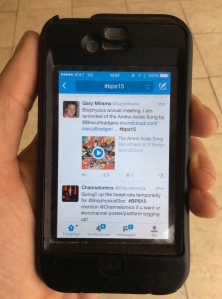
This is the biggest conference I ever go to; this morning there were two symposia and six platform sessions all running in parallel and, as often seems to be the case, the two I was interested in were about a five minute walk apart. In a, platform each speaker has just three minutes at the end of their talk where a fellow scientist may ask that question that saves six months work. Sometimes there are no questions from the floor. Imagine a different, a more, dare I say it, 21st century approach. And yes, it involves Twitter.
Imagine that, as you are speaking, members of the audience are posting questions or links to helpful papers on Twitter tagged with an appropriate hashtag. Maybe the feed is projected on a second screen so everyone, including the speaker and chairs, can follow it during the talk. In the question session the chair could simply pick out a few questions from the feed for the speaker to elaborate on. Or maybe the speaker tries to answer them as they go along. Either way you'd come away with having had a lot more interaction with your community, and almost as important, a permanent record of the questions and suggestions. (Can you remember word-for-word the questions you are asked after you've given a talk? I can't.) This might sound like fantasy but it isn't. I've been to smaller conferences, in computer or computational science, where this isn't far off the norm. See here for an interesting article on scientific tweeting
. Or, imagine you are sitting in a session and you see in the feed that the talk in the other session you were interested in is actually exactly what you've come all this way to see so you swap. Or, you see that the other session down the hall is running five minutes late so you can grab a coffee. Or, that a room key card for the hotel you are staying in has been handed in and so you check your pocket...
So how are we doing? Well in the last week there have been 206 tweets using the #bps15 hashtag from 98 accounts. That is not many, it works out at about one per thirty people attending. To get a live updating feed let's say you need about one per minute. That works out at over 3000 over the course of the conference (I think this is a lower limit). So we are about an order of magnitude below that simple estimate. Why? Well I think because most of us don't use social media like Twitter and, if you do, you know this and so are aware that no-one will read your tweets. In which case, what is the point? In other words we are below the tipping point (or perhaps I should say phase transition?).
Are things getting better? Last year there were 518 tweets using the #bps14 hashtag during the whole conference. So, yes, it looks like the trajectory is upwards. Of course Twitter isn't the only way of doing this. Maybe the social aspects to the new 360 app will take on the mantel, but I doubt it.
There have been five #bps15 tweets since I started writing this half an hour ago. Not bad, but not enough to change how this meeting works either.
--Philip W. Fowler